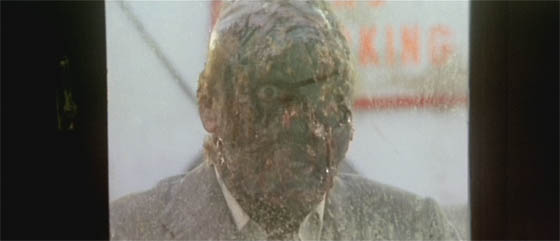 “Zombies don’t run.” Thus has declared, on multiple occasions, George A. Romero – and he should know. His films Night of the Living Dead (1968) and Dawn of the Dead (1978) are not just the key reference points in the Modern Zombie Film, but seminal works in the entire horror genre. His zombies are slow and lumbering, alternately frightening and comic. They don’t run because they can’t; their bodies are decomposing, after all, and with makeup artists such as Tom Savini, Romero lovingly demonstrated how many ways the human body can fall to pieces – and how horrific it is when it just keeps coming at you anyhow. He began to give the “zombies don’t run” quote while promoting his return to zombie filmmaking with Land of the Dead (2005). Zack Snyder had already made his remake of Dawn of the Dead (2004), and it was touted as a major innovation in the subgenre that his zombies were charging full speed at their victims. How much scarier. Why didn’t Romero think of that? Actually, Snyder was just borrowing from Danny Boyle’s not-quite-a-zombie-film 28 Days Later (2002), and even that movie set no precedents. No, zombies were in running sneakers at least as far back as 1980’s Italian/Spanish co-production Nightmare City, aka Incubo Sulla Città Contaminata. They were also wielding axes and machine guns, ravishing women, operating complicated machinery, and drinking blood like vampires. But Romero hardly had the breath to deny that zombies do all those things; most people could assume. Most, that is, except for Umberto Lenzi, maestro of Italian exploitation, who could care less about logic or consistency as long as it’s in-your-face, frame after frame.
“Zombies don’t run.” Thus has declared, on multiple occasions, George A. Romero – and he should know. His films Night of the Living Dead (1968) and Dawn of the Dead (1978) are not just the key reference points in the Modern Zombie Film, but seminal works in the entire horror genre. His zombies are slow and lumbering, alternately frightening and comic. They don’t run because they can’t; their bodies are decomposing, after all, and with makeup artists such as Tom Savini, Romero lovingly demonstrated how many ways the human body can fall to pieces – and how horrific it is when it just keeps coming at you anyhow. He began to give the “zombies don’t run” quote while promoting his return to zombie filmmaking with Land of the Dead (2005). Zack Snyder had already made his remake of Dawn of the Dead (2004), and it was touted as a major innovation in the subgenre that his zombies were charging full speed at their victims. How much scarier. Why didn’t Romero think of that? Actually, Snyder was just borrowing from Danny Boyle’s not-quite-a-zombie-film 28 Days Later (2002), and even that movie set no precedents. No, zombies were in running sneakers at least as far back as 1980’s Italian/Spanish co-production Nightmare City, aka Incubo Sulla Città Contaminata. They were also wielding axes and machine guns, ravishing women, operating complicated machinery, and drinking blood like vampires. But Romero hardly had the breath to deny that zombies do all those things; most people could assume. Most, that is, except for Umberto Lenzi, maestro of Italian exploitation, who could care less about logic or consistency as long as it’s in-your-face, frame after frame.
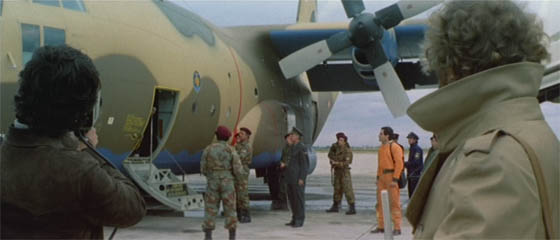 The film opens with a news report about a “radioactive spill” at a nearby nuclear plant. Dean Miller (Hugo Stiglitz), a news reporter, is dispatched to the airport to meet and interview a brilliant professor who will offer more details about the nuclear accident. On the runway, an unmarked military cargo plane sets down without authorization from the tower; Miller and his cameraman rush to the plane along with police and a squadron of armed soldiers. Out of the plane steps that brilliant professor – who immediately stabs a military officer with a giant knife. The soldiers open fire. Out of the plane erupts a mob of axe-wielding men, many of them in suits, most of them short and stocky, and all of them with mutated faces that resemble the Toxic Avenger’s. They seem impervious to bullets, and quickly steal the machine guns of their victims and begin using them. Miller and his cameraman spend an eternity watching this scene before finally Miller says, expressionless, “I don’t believe it. My God. Let’s get out of here. Go.”
The film opens with a news report about a “radioactive spill” at a nearby nuclear plant. Dean Miller (Hugo Stiglitz), a news reporter, is dispatched to the airport to meet and interview a brilliant professor who will offer more details about the nuclear accident. On the runway, an unmarked military cargo plane sets down without authorization from the tower; Miller and his cameraman rush to the plane along with police and a squadron of armed soldiers. Out of the plane steps that brilliant professor – who immediately stabs a military officer with a giant knife. The soldiers open fire. Out of the plane erupts a mob of axe-wielding men, many of them in suits, most of them short and stocky, and all of them with mutated faces that resemble the Toxic Avenger’s. They seem impervious to bullets, and quickly steal the machine guns of their victims and begin using them. Miller and his cameraman spend an eternity watching this scene before finally Miller says, expressionless, “I don’t believe it. My God. Let’s get out of here. Go.”
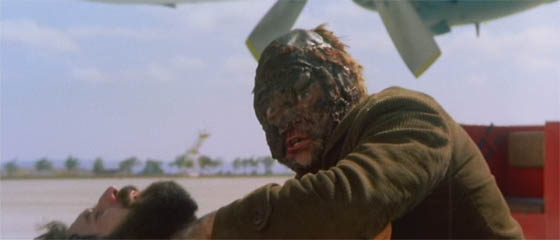 Back at the TV studio, a number of spandex-clad men and women are dancing before the cameras to a prolonged synthesizer instrumental, applying highly detailed choreography which involves lots of waving arms and spinning around. Behind them, a flashing sign says: “M-U-S-I-C.” Another sign is more specific: “DISCO MUSIC.” The studio crew members, wearing lab coats, gaze blankly at the dancers as though their souls were taken from them long, long ago. Miller arrives, demanding that the all-aerobics-dancing-program be interrupted for a special news flash. The dancers don’t take it well. Luckily, the TV announcer keeps the mood mellow and heavily sedated:
Back at the TV studio, a number of spandex-clad men and women are dancing before the cameras to a prolonged synthesizer instrumental, applying highly detailed choreography which involves lots of waving arms and spinning around. Behind them, a flashing sign says: “M-U-S-I-C.” Another sign is more specific: “DISCO MUSIC.” The studio crew members, wearing lab coats, gaze blankly at the dancers as though their souls were taken from them long, long ago. Miller arrives, demanding that the all-aerobics-dancing-program be interrupted for a special news flash. The dancers don’t take it well. Luckily, the TV announcer keeps the mood mellow and heavily sedated:
Dean Miller’s news flash is interrupted as soon as it’s begun. Into the studio stomps General Murchison (Mel Ferrer, Eaten Alive), none too pleased that Miller thought that machine gun-wielding zombies slaughtering police officers and military personnel at the airport was news that the public should know about. Miller stands up to the general by proclaiming, “In a democratic country, nobody is allowed to interfere with the freedom of the press. For any reason, whatsoever!” So the general decides to further ignore everything that comes out of Miller’s mouth, turns around, and asks the station manager for compliance, a request which is promptly granted.
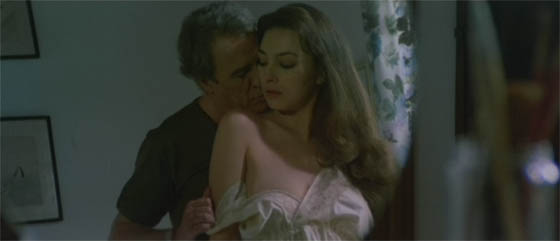
Meanwhile, Major Holmes (Francisco Rabal, Viridiana) is enjoying a day off with his beautiful young wife (Maria Rosaria Omaggio) by engaging in a synthesizer-fueled sex scene, when he’s interrupted by a phone call urging him to return to headquarters. But she refuses to let him leave until they’ve further established significant character information. Catching her husband staring at a clay bust which she sculpted in the shape of a deformed and monstrous visage, she asks:
“Don’t you like it?”
“On the contrary. But every time I look at it, I get a feeling of…”
“Of death. Is that what you were going to say?”
“It’s funny, but it’s the first time that one of your works has given me a feeling like that. It’s the truth, I’m sorry.”
“I can’t say that you’re wrong. When I look at it objectively, I mean when I’m not actually working on it, I almost get the feeling that I wasn’t the one who made it, but some other being outside of me. It frightens me.”
“That sounds like science fiction.”
“Metaphysics, if you want.”
Here’s what you need to know: this dialogue has nothing to do with anything else that happens in the film. So let’s just pretend it didn’t happen. Back to aerobic dancing in the TV studio, and more synthesizers, while the crew stares, and stares, and stares. MTV was still a year away, so this was all they had. The hypnotic scene is interrupted when short, stocky, axe-wielding zombies burst into the studio and begin graphically slaughtering everyone. Meanwhile, the dancers and crew run back and forth like chickens until they can be picked off by the zombies. Only Miller, loose cannon news reporter that he is, has the idea to actually leave the studio by using the door.
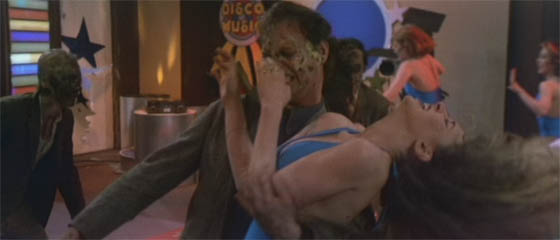
Over at the local hospital, Miller’s wife, Dr. Anna Miller (Laura Trotter), consoles a young teenager that he’ll be back to playing football in no time, even though he’s been having premonitions that he’ll lose his leg in an explosion. “It was all about my leg!” (Actually, he’ll just get killed in his hospital bed by a zombie, his leg unviolated, so no worries there.)
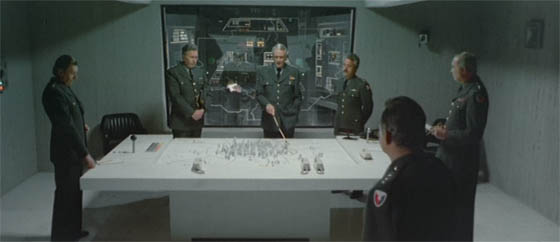 But we’ll get to that in a bit. Over at “headquarters,” General Murchison debriefs Major Holmes and some other high-ranking officers over a scale model of the city (whichever city this is – Madrid, or Rome, or Cleveland). A dead zombie is wheeled into the room on a cart. General Murchison immediately states, “The autopsy excludes the possibility of an extraterrestrial being.” With that out of the way, Colonel Donahue of the Institute for Atomic Research explains how a radiation-altered, blood-sucking, highly zombie-esque super-mutant functions – in the most medically scientific way Nightmare City can. “The abnormal strengthening of the cells’ vital qualities has increased their direct genetic capacity. In other words…the victims of these creatures are contaminated, even if they only suffer minor injuries.” He continues, “Atomic contamination destroys the efficiency of red blood cells in very short order. That is why new blood is always needed for these creatures. True, the human organism is greatly strengthened. However, the power still remains the brain. A lesion to the nerve centers can produce paralysis. The procedure stops the complex entirely.” The Major asks, “You mean only bullets to the cranium can stop these – these monsters?” The Colonel agrees by suggesting that the “cerebral apparatus” will need to be destroyed. So you see, zombies can infect others to make more zombies, and the only way to kill one is to somehow incapacitate its cranial cerebral apparatus mechanism which is inside its head, called, in layman’s terms, a “brain.” Now the film has spent five minutes explaining this to you.
But we’ll get to that in a bit. Over at “headquarters,” General Murchison debriefs Major Holmes and some other high-ranking officers over a scale model of the city (whichever city this is – Madrid, or Rome, or Cleveland). A dead zombie is wheeled into the room on a cart. General Murchison immediately states, “The autopsy excludes the possibility of an extraterrestrial being.” With that out of the way, Colonel Donahue of the Institute for Atomic Research explains how a radiation-altered, blood-sucking, highly zombie-esque super-mutant functions – in the most medically scientific way Nightmare City can. “The abnormal strengthening of the cells’ vital qualities has increased their direct genetic capacity. In other words…the victims of these creatures are contaminated, even if they only suffer minor injuries.” He continues, “Atomic contamination destroys the efficiency of red blood cells in very short order. That is why new blood is always needed for these creatures. True, the human organism is greatly strengthened. However, the power still remains the brain. A lesion to the nerve centers can produce paralysis. The procedure stops the complex entirely.” The Major asks, “You mean only bullets to the cranium can stop these – these monsters?” The Colonel agrees by suggesting that the “cerebral apparatus” will need to be destroyed. So you see, zombies can infect others to make more zombies, and the only way to kill one is to somehow incapacitate its cranial cerebral apparatus mechanism which is inside its head, called, in layman’s terms, a “brain.” Now the film has spent five minutes explaining this to you.
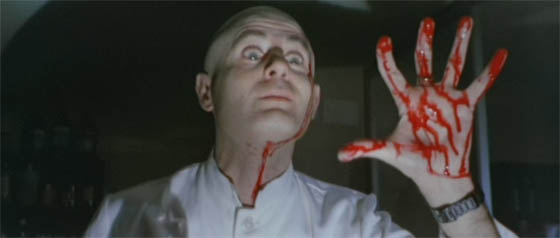 The outbreak is spreading, but General Murchison insists that the public not be notified; even while he and Major Holmes both secretly notify their loved ones to stay inside and lock the doors. Zombies attack the hospital just as Miller arrives to get his wife. They flee safely, barely outwitting those zombies, who prove to be more organized than anyone should reasonably expect. One zombie even figures out how to operate the pulley of an elevator, so he can draw it up and empty its occupants straight into the hands of the monsters. Another invades a hospital room and greedily devours the contents of a blood bag. There are so many zombies that Umberto Lenzi can barely spare the makeup. (This is an ongoing issue.) In another military conference, someone suggests to General Murchison that maybe it’s time to inform the public, as they might be figuring things out pretty soon, but he remains unconvinced. The next day, his daughter and her husband, who have ignored the general’s advice so they can enjoy a vacation in their RV in a field of weeds by the side of the freeway, are the next victims of the zombie invasion.
The outbreak is spreading, but General Murchison insists that the public not be notified; even while he and Major Holmes both secretly notify their loved ones to stay inside and lock the doors. Zombies attack the hospital just as Miller arrives to get his wife. They flee safely, barely outwitting those zombies, who prove to be more organized than anyone should reasonably expect. One zombie even figures out how to operate the pulley of an elevator, so he can draw it up and empty its occupants straight into the hands of the monsters. Another invades a hospital room and greedily devours the contents of a blood bag. There are so many zombies that Umberto Lenzi can barely spare the makeup. (This is an ongoing issue.) In another military conference, someone suggests to General Murchison that maybe it’s time to inform the public, as they might be figuring things out pretty soon, but he remains unconvinced. The next day, his daughter and her husband, who have ignored the general’s advice so they can enjoy a vacation in their RV in a field of weeds by the side of the freeway, are the next victims of the zombie invasion.
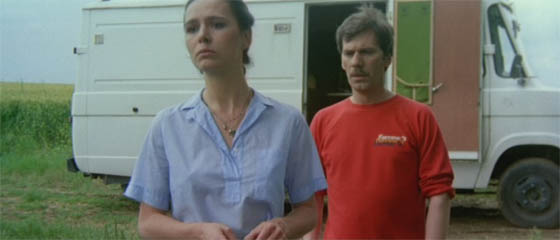 While Major Holmes’ sculptor wife takes in a fugitive, and the two of them battle zombies that have invaded their house, Mr. and Mrs. Miller take to the road in one of the hospital’s emergency vehicles, and drive until they need gas. The gas station seems deserted, so rather than just filling his tank and splitting, Dean insists on exploring. Sure enough, there really are zombies there after all, and within moments they’ve taken over his car and are just kinda drinking blood packs and hanging out and stuff.
While Major Holmes’ sculptor wife takes in a fugitive, and the two of them battle zombies that have invaded their house, Mr. and Mrs. Miller take to the road in one of the hospital’s emergency vehicles, and drive until they need gas. The gas station seems deserted, so rather than just filling his tank and splitting, Dean insists on exploring. Sure enough, there really are zombies there after all, and within moments they’ve taken over his car and are just kinda drinking blood packs and hanging out and stuff.
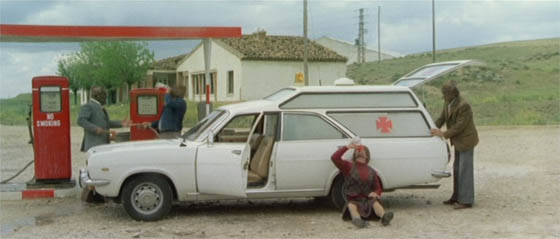 Dean lights a Molotov cocktail and flings it at the car. Look quick, before the car explodes, and you’ll see that the zombies have been replaced by some convincing stand-ins:
Dean lights a Molotov cocktail and flings it at the car. Look quick, before the car explodes, and you’ll see that the zombies have been replaced by some convincing stand-ins:
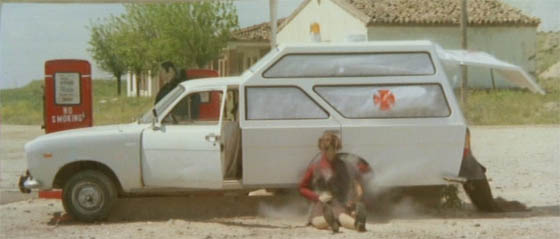 And boom.
And boom.
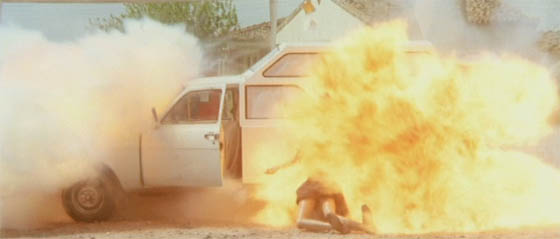 Following this slaughter, Dean tries to help his wife through her nervous breakdown with a rapid-fire treatment of booze, physical abuse, and passionate kissing:
Following this slaughter, Dean tries to help his wife through her nervous breakdown with a rapid-fire treatment of booze, physical abuse, and passionate kissing:
By now, the zombies have taken over the city. Rather than delivering epic shots of dead bodies strewn about vast urban landscapes, the film instead treats us to a scene with a helicopter hovering over a big open field filled with zombie extras, most of them lacking monster makeup, all of them running back and forth aimlessly, as though engaging in an Ultimate Frisbee match. (If you look closely, there’s a dog running back and forth with the zombies, probably thinking this is awesome.)
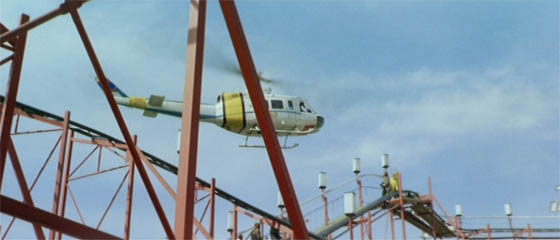 After Dean and Ann Miller take refuge in a church, they confront a zombie priest, who immediately attacks them with a giant candlestick; Dean kills him with a candlestick holder. They move on to the next level of the video game, which takes place at an amusement park. For the film’s big climax, the two are backed up against a roller coaster, and are forced to climb the tracks, the zombies in pursuit. Soldiers arrive in a helicopter, and drop a ladder, while Dean lobs grenades and fires round after round at the zombies. Then…tragedy ensues. Please, don’t reveal to anyone the terrifying twist ending of Nightmare City:
After Dean and Ann Miller take refuge in a church, they confront a zombie priest, who immediately attacks them with a giant candlestick; Dean kills him with a candlestick holder. They move on to the next level of the video game, which takes place at an amusement park. For the film’s big climax, the two are backed up against a roller coaster, and are forced to climb the tracks, the zombies in pursuit. Soldiers arrive in a helicopter, and drop a ladder, while Dean lobs grenades and fires round after round at the zombies. Then…tragedy ensues. Please, don’t reveal to anyone the terrifying twist ending of Nightmare City:
But the nightmare of Nightmare City never ends. Miller, shaking off the last 90 minutes just as easily as the audience wishes they could, heads out to the airport to chase his latest news scoop. An unmarked military cargo plane is landing, and police and the military are gathering anxiously around it. The door to the plane opens. The tension rises, or probably stays at about the same level, or perhaps drops limply in exhaustion. And out of the plane comes…short, stocky zombies with axes. We are in a Möbius strip. And the makeup has not gotten any better.









